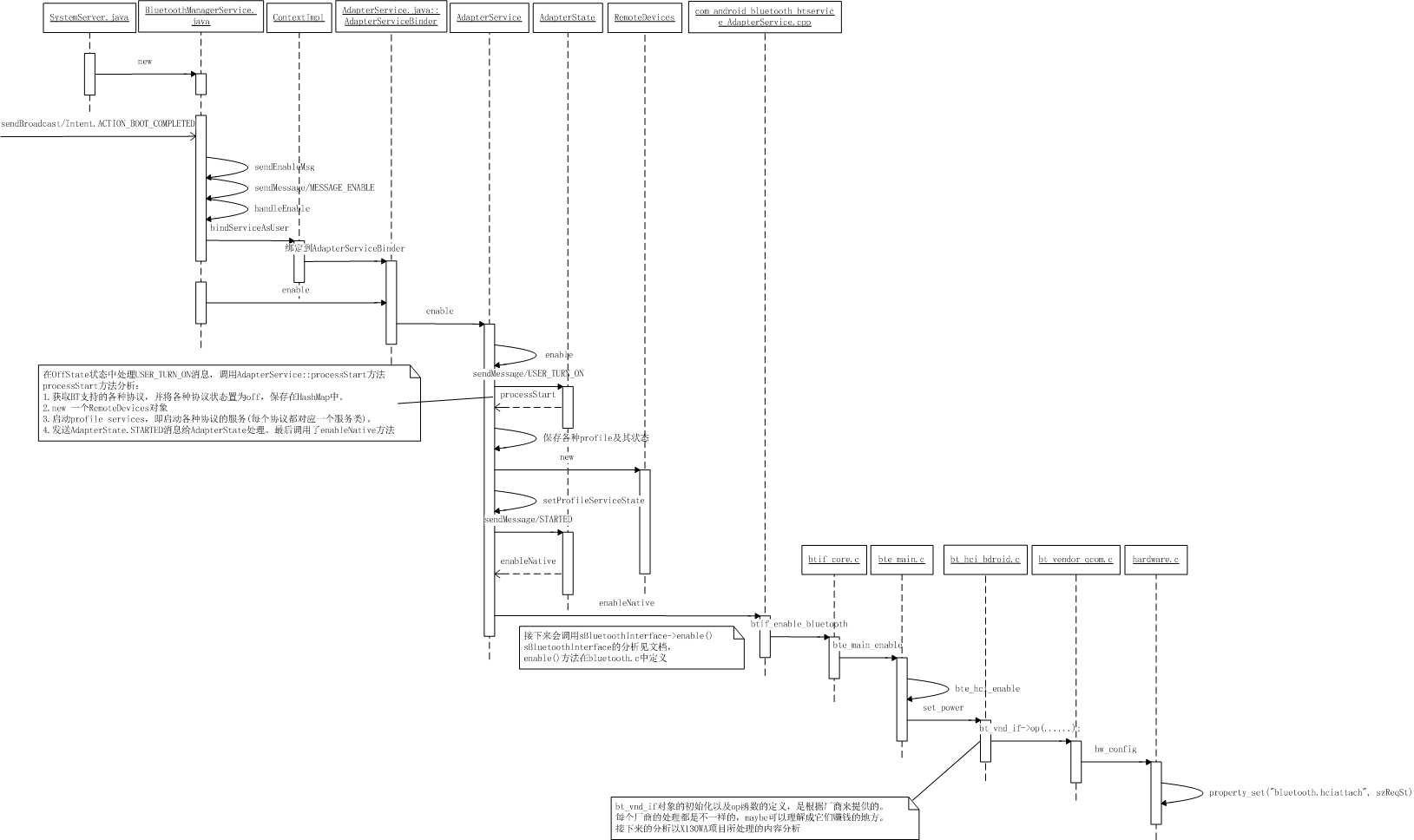标签:address 也有 imp break ems roman 模块 arch 定义
android4.3中引入了蓝牙低能耗le(low energy),相应的也有一些方法/类。不过代码里,并没有找到初始调用的地方。所以这里还是先只分析下bt普通的扫描流程(类似android 4.2),先贴出流程图

主要通过“扫描”的流程来分析下
BluetoothSettings.java::startScanning ----package
LocalBluetoothAdapter.java::startScanning ----package
BluetoothAdapter.java::startDiscovery ----framework
AdapterService.java::startDiscovery ----package
com_android_bluetooth_btservice_AdapterService.cpp::startDiscoveryNative -jni
从这里开始分析下用到的一些变量和结构体
首先看startDiscoveryNative方法:
static jboolean startDiscoveryNative(JNIEnv* env, jobject obj) {
ALOGV("%s:",__FUNCTION__);
jboolean result = JNI_FALSE;
if (!sBluetoothInterface) return result;
int ret = sBluetoothInterface->start_discovery();
result = (ret == BT_STATUS_SUCCESS) ? JNI_TRUE : JNI_FALSE;
return result;
}
分析点: int ret = sBluetoothInterface->start_discovery();
----------------------------------------------------------------------------
sBluetoothInterface的来源
查看com_android_bluetooth_btservice_AdapterService.cpp所在目录的Android.mk文件,
......
LOCAL_SHARED_LIBRARIES := libandroid_runtime libnativehelper libcutils libutils liblog libhardware
......
libhardware是编译时用到的,一般都是在hardware目录中。然后可以在子目录libhardware下找到bluetooth.h。在bluetooth.h中定义了bt_interface_t结构体。继而寻找该结构体对象的创建位置。在external/bluetooth/bluedroid/btif/src/bluetooth.c文件中找到。如下所示:
static const bt_interface_t bluetoothInterface = {
sizeof(bluetoothInterface),
init,
enable,
disable,
cleanup,
get_adapter_properties,
get_adapter_property,
set_adapter_property,
get_remote_device_properties,
get_remote_device_property,
set_remote_device_property,
get_remote_service_record,
get_remote_services,
start_discovery,
cancel_discovery,
create_bond,
remove_bond,
cancel_bond,
pin_reply,
ssp_reply,
get_profile_interface,
dut_mode_configure,
dut_mode_send,
#if BLE_INCLUDED == TRUE
le_test_mode
#else
NULL
#endif
};
sBluetoothInterface对象便是获得了bluetoothInterface对象。
接下来,打开蓝牙、扫描等功能就会通过sBluetoothInterface调用结构体中声明的相应方法了。
流程:settings界面发起,LocalBluetoothAdapter.java过渡,去framework的转转(BluetoothAdapter.java)后,回到packages的AdapterService.java,再走JNI,接着去external处理。
----------------------------------------------------------------------------
接下来,跟一遍star_discovery
1.已经找到JNI层startDiscoveryNative函数对应的start_discovery方法(bluetooth.c),分析之。
static int start_discovery(void)
{
/* sanity check */
if (interface_ready() == FALSE)
return BT_STATUS_NOT_READY;
return btif_dm_start_discovery();
}
2.分析btif_dm_start_discovery方法(btif_dm.c)
bt_status_t btif_dm_start_discovery(void)
{
tBTA_DM_INQ inq_params;
tBTA_SERVICE_MASK services = 0;
BTIF_TRACE_EVENT1("%s", __FUNCTION__);
/* TODO: Do we need to handle multiple inquiries at the same time? */
/* Set inquiry params and call API */
#if (defined(BLE_INCLUDED) && (BLE_INCLUDED == TRUE))
inq_params.mode = BTA_DM_GENERAL_INQUIRY|BTA_BLE_GENERAL_INQUIRY;
#else
inq_params.mode = BTA_DM_GENERAL_INQUIRY;
#endif
inq_params.duration = BTIF_DM_DEFAULT_INQ_MAX_DURATION;
inq_params.max_resps = BTIF_DM_DEFAULT_INQ_MAX_RESULTS;
inq_params.report_dup = TRUE;
inq_params.filter_type = BTA_DM_INQ_CLR;
/* TODO: Filter device by BDA needs to be implemented here */
/* Will be enabled to TRUE once inquiry busy level has been received */
btif_dm_inquiry_in_progress = FALSE;
/* find nearby devices */ //下面是关键语句
BTA_DmSearch(&inq_params, services, bte_search_devices_evt);
return BT_STATUS_SUCCESS;
(1) BTA_DmSearch分析
void BTA_DmSearch(tBTA_DM_INQ *p_dm_inq, tBTA_SERVICE_MASK services, tBTA_DM_SEARCH_CBACK *p_cback)
{
tBTA_DM_API_SEARCH *p_msg;
if ((p_msg = (tBTA_DM_API_SEARCH *) GKI_getbuf(sizeof(tBTA_DM_API_SEARCH))) != NULL)
{
memset(p_msg, 0, sizeof(tBTA_DM_API_SEARCH));
p_msg->hdr.event = BTA_DM_API_SEARCH_EVT;
memcpy(&p_msg->inq_params, p_dm_inq, sizeof(tBTA_DM_INQ));
p_msg->services = services;
p_msg->p_cback = p_cback;
p_msg->rs_res = BTA_DM_RS_NONE;
bta_sys_sendmsg(p_msg);
}
}
看来只是发出一个消息,传递参数值。
(2)bte_search_devices_evt (btif_dm.c)
这条语句中,bte_search_devices_evt是真正用来搜索的,分析这个方法。贴出代码:
static void bte_search_devices_evt(tBTA_DM_SEARCH_EVT event, tBTA_DM_SEARCH *p_data)
{
UINT16 param_len = 0;
if (p_data)
param_len += sizeof(tBTA_DM_SEARCH);
/* Allocate buffer to hold the pointers (deep copy). The pointers will point to the end of the tBTA_DM_SEARCH */
switch (event)
{
case BTA_DM_INQ_RES_EVT:
{
if (p_data->inq_res.p_eir)
param_len += HCI_EXT_INQ_RESPONSE_LEN;
}
break;
case BTA_DM_DISC_RES_EVT:
{
if (p_data->disc_res.raw_data_size && p_data->disc_res.p_raw_data)
param_len += p_data->disc_res.raw_data_size;
}
break;
}
BTIF_TRACE_DEBUG3("%s event=%s param_len=%d", __FUNCTION__, dump_dm_search_event(event), param_len);
/* if remote name is available in EIR, set teh flag so that stack doesnt trigger RNR */
if (event == BTA_DM_INQ_RES_EVT)
p_data->inq_res.remt_name_not_required = check_eir_remote_name(p_data, NULL, NULL);
btif_transfer_context (btif_dm_search_devices_evt , (UINT16) event, (void *)p_data, param_len,
(param_len > sizeof(tBTA_DM_SEARCH)) ? search_devices_copy_cb : NULL);
}
看注释,这个方法作用就是Switches context from BTE to BTIF for DM search events,即将context从bte传给btif中的dm search事件。所以关键点在于btif_dm_search_devices_evt方法(btif_dm.c文件中定义),继续贴代码:
static void btif_dm_search_devices_evt (UINT16 event, char *p_param)
{
switch (event)
{
case BTA_DM_INQ_RES_EVT:
{
/* inquiry result */
UINT32 cod;
UINT8 *p_eir_remote_name = NULL;
bt_bdname_t bdname;
bt_bdaddr_t bdaddr;
UINT8 remote_name_len;
UINT8 *p_cached_name = NULL;
tBTA_SERVICE_MASK services = 0;
bdstr_t bdstr;
p_search_data = (tBTA_DM_SEARCH *)p_param;
//解析mac地址
bdcpy(bdaddr.address, p_search_data->inq_res.bd_addr);
/* Callback to notify upper layer of device */
//下面是关键语句,回调方法
HAL_CBACK(bt_hal_cbacks, device_found_cb,
num_properties, properties);
}
}
break;
......
HAL_CBACK会注册回调方法,这里,会调用结构体对象bt_hal_cbacks中的device_found_cb方法。
继续扩展:
(a) bt_hal_cbacks对象分析 (根据初始化流程分析从头分析该bt_hal_cback对象的由来)
(a.1)首先,在AdapterService.java::onCreate方法中,有initNative方法。在相应JNI文件com_android_bluetooth_btservice_AdapterService.cpp中找到该方法,如下:
static bool initNative(JNIEnv* env, jobject obj) {
ALOGV("%s:",__FUNCTION__);
......
if (sBluetoothInterface) {
int ret = sBluetoothInterface->init(&sBluetoothCallbacks);
......
}
(a.1.1)该JNI文件中定义了sBluetoothCallbacks,如下:
bt_callbacks_t sBluetoothCallbacks = {
sizeof(sBluetoothCallbacks),
adapter_state_change_callback,
adapter_properties_callback,
remote_device_properties_callback,
device_found_callback,
discovery_state_changed_callback,
pin_request_callback,
ssp_request_callback,
bond_state_changed_callback,
acl_state_changed_callback,
callback_thread_event,
dut_mode_recv_callback,
le_test_mode_recv_callback
};
bt_callbacks_t结构体的定义在hardware/libhardware/include/hardware/bluetooth.h中,代码如下:
/** Bluetooth DM callback structure. */
typedef struct {
/** set to sizeof(bt_callbacks_t) */
size_t size;
adapter_state_changed_callback adapter_state_changed_cb;
adapter_properties_callback adapter_properties_cb;
remote_device_properties_callback remote_device_properties_cb;
device_found_callback device_found_cb;
discovery_state_changed_callback discovery_state_changed_cb;
pin_request_callback pin_request_cb;
ssp_request_callback ssp_request_cb;
bond_state_changed_callback bond_state_changed_cb;
acl_state_changed_callback acl_state_changed_cb;
callback_thread_event thread_evt_cb;
dut_mode_recv_callback dut_mode_recv_cb;
le_test_mode_callback le_test_mode_cb;
} bt_callbacks_t;
(a.1.2) 分析sBluetoothInterface对象的init方法。
因为sBluetoothInterface对象的值也是在bluetooth.c文件中定义的bluetoothInterface对象赋值的,所以直接找bluetoothInterface对象的定义处。
static const bt_interface_t bluetoothInterface = {
sizeof(bluetoothInterface),
init,
enable,
disable,
cleanup,
get_adapter_properties,
get_adapter_property,
set_adapter_property,
get_remote_device_properties,
get_remote_device_property,
set_remote_device_property,
get_remote_service_record,
get_remote_services,
start_discovery,
cancel_discovery,
create_bond,
remove_bond,
cancel_bond,
pin_reply,
ssp_reply,
get_profile_interface,
dut_mode_configure,
dut_mode_send,
#if BLE_INCLUDED == TRUE
le_test_mode
#else
NULL
#endif
};
在该结构体中找到init方法,然后继续在bluetooth.c中找init方法的定义。
static int init(bt_callbacks_t* callbacks )
{
ALOGI("init");
/* sanity check */
if (interface_ready() == TRUE)
return BT_STATUS_DONE;
/* store reference to user callbacks */
bt_hal_cbacks = callbacks; //这里为bt_hal_cbacks对象赋值
/* add checks for individual callbacks ? */
bt_utils_init();
/* init btif */
btif_init_bluetooth();
return BT_STATUS_SUCCESS;
}
通过上面标注的语句就知道了bt_hal_cback对象的由来,即sBluetoothCallbacks对象。
(b) HAL_CBACK分析
#define HAL_CBACK(P_CB, P_CBACK, ...) if (P_CB && P_CB->P_CBACK) { BTIF_TRACE_API2("HAL %s->%s", #P_CB, #P_CBACK); P_CB->P_CBACK(__VA_ARGS__); } else { ASSERTC(0, "Callback is NULL", 0); }
这个宏主要就是执行了P_CB->P_CBACK(__VA_ARGS__); 在这里就是bt_hal_cback-> device_found_cb(...)方法。然后找到 sBluetoothCallbacks对象中对应的方法device_found_callback,继而找到该方法定义处。
static void device_found_callback(int num_properties, bt_property_t *properties) {
......
callbackEnv->CallVoidMethod(sJniCallbacksObj, method_deviceFoundCallback, addr);
......
JNI层的method_deviceFoundCallback函数对应java层的deviceFoundCallback方法,在JniCallbacks.java中。该类中又会调用RemoteDevice.java中的deviceFoundCallback方法。
然后,该回调方法中会发出广播,action为BluetoothDevice.ACTION_FOUND。这个广播会在BluetoothEventManager.java中处理。该类中通过addHandler方法,将action的值与相关handler接口类绑定。
接下来其他方法的处理,基本上也是这个套路。
总结下扫描的流程:
1.BluetoothEnabler类中调用startScanning方法,继而会调用LocalBluetoothAdapter,然后进入framework层,调用BluetoothAdapter中的startDiscovery方法,然后调用了AdapterService::startDiscovery(ps:在BluetoothAdapter类中,有mService和mMangerService对象,前一个代表AdapterService,后一个指BluetoothManagerService,比如enable BT的时候,就会调用BluetoothManagerService的方法,这个具体分析的时候要注意)。接着,会调用JNI层com_android_bluetooth_btservice_AdapterService.cpp中的startDiscoveryNative方法。
这个流程其实还是蛮清晰的,从上层应用执行到中间层再准备到协议栈external中去了。
下面就开始纠结了,各层跳来跳去:即external的分析
startDiscoveryNative (JNI层)---> sBluetoothInterface->start_discovery() (bluetooth.c中)---> btif_dm_start_discovery方法 (btif_dm.c)---> BTA_DmSearch(&inq_params, services, bte_search_devices_evt);---> bte_search_devices_evt---> btif_dm_search_devices_evt---> HAL_CBACK(bt_hal_cbacks, remote_device_properties_cb, status, &bdaddr, 1, properties);---> remote_device_properties_callback (JNI层)--->callbackEnv->CallVoidMethod(sJniCallbacksObj, method_deviceFoundCallback, addr, types, props);--> deviceFoundCallback (packages/apps/Bluetooth..JniCallbacks.java)--> deviceFoundCallback (packages/apps/Bluetooth..RemoteDevices.java)--->在RemoteDevices.java中会发出广播,action为BluetoothDevice.ACTION_FOUND。--->广播接收者(packages/apps/Settings/..../BluetoothEventManager.java)在其初始化方法中,为每个action绑定了一个名为XXHander的接口类,即以键值对形式保存。在广播的onReceive方法中,调用相应接口类处理。--->调用dispatchDeviceAdded方法 (还是在BluetoothEventManager.java中)ps:在这个方法中,会调用之前注册的回调类(这个回调类是DeviceListPreferenceFragment.java)的onDeviceAdded方法。---> DeviceListPreferenceFragment.java::onDeviceAdded(还是在Settings模块中)---> DeviceListPreferenceFragment.java::createDevicePreference方法 |
标签:address 也有 imp break ems roman 模块 arch 定义
原文地址:http://www.cnblogs.com/Free-Thinker/p/6418251.html